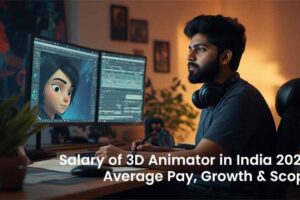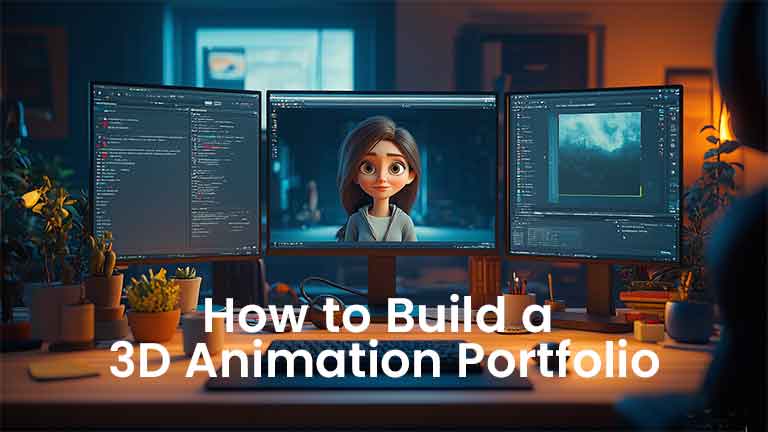
How to Build a 3D Animation Portfolio That Gets You Hired
Because they know how to present their skills. They’ve got a killer 3D animation portfolio that screams – “I’m ready for this 3D Animation industry.”
Now, you might be thinking… where do I even start? Don’t worry. I’ve been there. I’ve been guiding students and pros alike for 15+ years now. And today? I’m gonna tell you everything that works. Real talk.
Let’s dive in. But first, basics like adobe suite software.
🎨 So… What Even Is 3D Animation?
Alright, quick story – a decade ago, I was teaching flash-based animation. 2D stuff. Flat. Then one of my students showed me a dinosaur he rigged in Maya. It moved. It breathed. That moment? Changed everything.
3D animation isn’t drawing frames. It’s building a whole digital world. Characters. Movements. Lighting. It’s like playing God with pixels. From games and movies to ad films and AR apps – it’s everywhere now.
And to join this world? You need to show you belong. That’s where your 3D animation portfolio comes in.
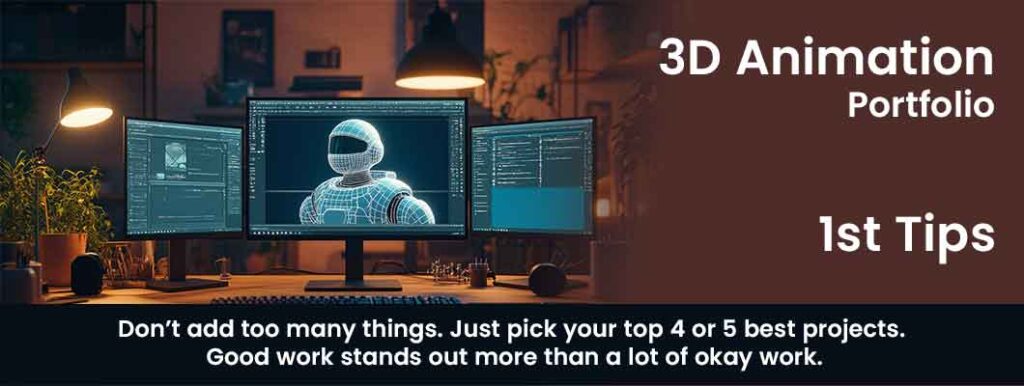
📁 What Should Your Animation Portfolio Have?
Let’s be honest. Nobody’s got time to scroll through every project you ever touched.
They wanna see your best stuff. Just the gold.
Think of your portfolio like a movie trailer — fast, sharp, and damn impressive.
Here’s what needs to go in:
- 🎬 A killer showreel.
Not too long. 1 to 2 minutes tops. Make it punchy. Your best scenes, well-edited. The kind that makes someone stop scrolling and say, “Whoa.” - 🎨 4 to 5 stunning pieces.
That’s it. Not 15. Not 25. Just the ones that show range. A stylized shot. A realistic render. Maybe a creature. Maybe a walk cycle that feels like real life. - ✍️ Break it down.
Add a few lines under each piece. What was your role? Did you model it? Animate it? Light it? Just be real. Keep it simple. - 🛠️ Skills list.
Don’t be shy. Mention tools like Maya, Blender, ZBrush, After Effects… whatever you’ve touched and actually know how to use. - 😊 Add a bit of you.
Not a life story. Just a small para—who you are, where you’re from, and what pulled you into animation. Make it honest. Let them feel something.
Because in the end, portfolios that stand out aren’t just technical—they feel personal. They tell a story. Your story.
🧩 Essential Elements of a Kickass Portfolio

- 🎯 Quality Beats Quantity
Let’s get real. Nobody’s scrolling through 40+ renders. They won’t. I once had to review a student’s portfolio—he had forty-three pieces in there. Guess how many I clicked? Just three.
And that’s me being nice.
So yeah… stop flooding. Just pick your strongest 4–5. Clean. Polished. Let ’em shine. That’s what makes ’em stay.
- 🎮 Make It Relevant
Your dream is gaming? Then show game stuff. Real-time assets. Low poly. Good topology.
Wanna get into animation for movies? Go deep on emotions, body mechanics, character performance. No need to show a bouncing ball if you’re targeting Pixar-level storytelling.
Match your reel to the job. Simple logic. Makes a big difference.
- 📝 Write Something About Each Work
Nobody’s asking for a biography. But don’t leave them guessing either.
Just add a few lines under every piece.
Something like,
“I designed and modeled the dragon in ZBrush, textured it in Substance Painter, and rendered in Arnold.”
That’s it. Done. It shows you know your process. Shows you care. Shows ownership.
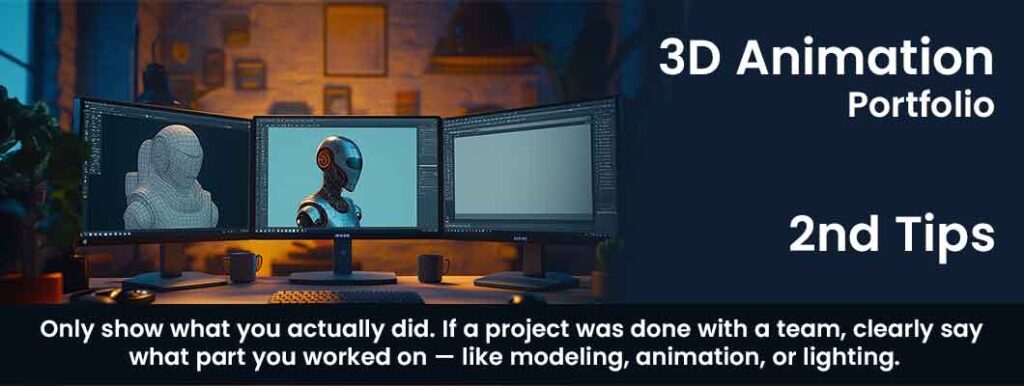
- 🖼️ Make It Look Good
Your work’s amazing. But if it’s sitting in a messy layout? Bad fonts? Pixelated thumbnails?
It’s gonna flop.
Keep it clean. Use ArtStation or Behance if you’re just starting. They look pro. But hey, if you can build your own site—even better. Keep it simple. No autoplay music. No flash. Just fast, clean, and visual.
It’s your shop window. Dress it well.
- ♻️ Keep It Fresh
Still showing that college assignment from 2018?
Yikes. 😬
If you haven’t updated your reel in 5 years, people will assume you haven’t grown. Even if you’ve only made one solid project in 6 months—add it. Replace the older stuff.
A stale portfolio is a big red flag. Keep things moving.

🛠️ How to Actually Build Your 3D Animation Portfolio
- 🪜 Step 1: Find Your Niche (Or at least lean toward one)
Look, you don’t need to do everything. And you probably shouldn’t.
If you love character animation, double down on that. Show the bounce, the emotion, the timing.
If sculpting’s your jam, then flex your ZBrush skills. Detail. Folds. Wrinkles. Monsters.
Point is—don’t try to impress by doing all of it. It confuses people.
Studios don’t wanna see a generalist with okay-ish work in ten things.
They wanna see someone great at one or two.
So yeah… pick a lane. Or at least lean toward one.
- 🧳 Step 2: Gather Your Best Work
Time to dig. Open your old hard drives.
Look through all those half-finished projects, college stuff, and forgotten renders.
Pick 5–6 that still hold up. You’ll know them when you see them.
If they need a touch-up, re-render. Maybe fix the lighting. Add motion blur.
But if it makes you cringe now? Toss it. Seriously. Just delete.
A clean reel with 4 bangers >>> a reel with 10 average shots.
- 🎬 Step 3: Build a Killer Showreel
This one’s important. It’s your trailer. Your pitch. Your first impression.
Start with your strongest shot. Like BOOM, straight into the action.
Don’t build up slowly. People don’t wait. They click away.
Keep it short—1 to 2 mins. Tops.
Cut it clean. Use music (but make sure it’s not copyrighted unless you love takedowns).
Use smooth transitions. Add your name, email, Insta handle—whatever contact you use.
And yes, put that info at the end too. Always.
Remember, this is what gets you interviews. Don’t rush it.
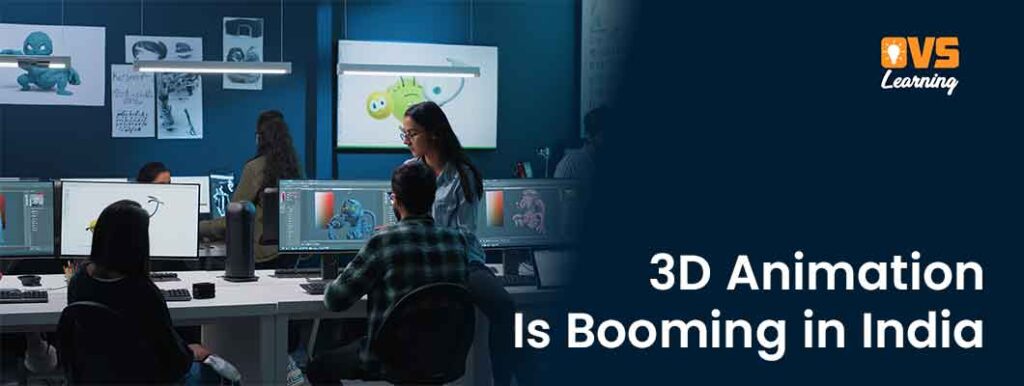
- 🧠 Step 4: Break Things Down
Okay, now this is where many mess up. They show a great dragon… but don’t say what they did.
Did you model it? Cool, write that.
Did someone else do the rig, and you just animated? Say it.
People wanna know what you actually did.
It’s not about bragging. It’s about clarity.
Studios don’t want guesswork.
- 🌐 Step 5: Go Online
If it’s not online, it basically doesn’t exist.
Post it all. Behance. ArtStation. Or your own website.
Doesn’t need to be fancy. Just clean and easy to scroll.
And hey—optimize it for phones. Most people will view it on their lunch break, swiping with one hand.
Also, keep links short. Like yourname.artstation.com — not something like /project/273635_46_g_hjks.
- 🗣️ Step 6: Ask for Feedback
Once you think it’s done… it’s not. Not yet.
Send it to your mentors. Old teachers. Friends already in the industry.
Ask them to roast it (nicely, hopefully).
What works? What doesn’t?
Take notes. Make changes. Recut if needed.
That loop—of feedback and fixing—is where good portfolios become great.
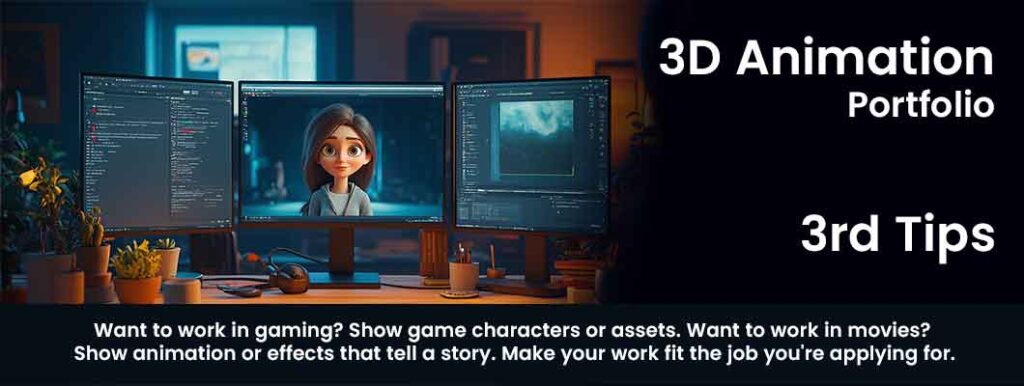
🎯 Tips to Make Your 3D Animation Portfolio Stand Out
Keep it clean. Always.
Don’t go crazy with fonts, moving backgrounds, or neon buttons.
Your work should shine—not your web design skills (unless you’re applying as a web designer).
Stick to your vibe.
If your style is stylized, cartoonish, low-poly—own it.
Don’t force hyper-realism just ’cause others do it. Be real. Be you.
No faking skills. Please.
Look, studios can spot fake flexes from a mile away.
Don’t say you rigged something if you didn’t.
Don’t name-drop software just to impress. It backfires.
Lighting.
It changes everything.
Even a basic cube looks sexy with proper lights and shadows.
So spend time on lighting your scenes. It’s a big deal. Huge.
Show a bit of you.
Throw in a short para—”Why I Animate” or “My Journey in 3D” or just “Stuff I Love Making.”
Keep it honest. Keep it messy if it feels more you.
People like knowing there’s a human behind the pixels.
Bonus?
Avoid background music on auto-play. It’s annoying.
And test your site. Click all links. Make sure it doesn’t break on mobile.
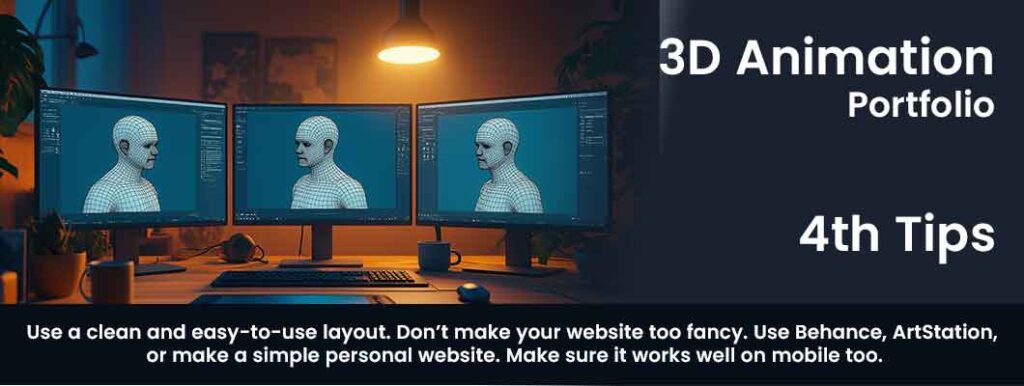
❓ FAQs (Because You’re Probably Wondering This Too)
Q1: How long should my 3D animation showreel be?
A: 1-2 minutes. That’s all. Trust me, no one watches beyond that unless they’re hooked.
Q2: Should I include team projects?
A: Sure, but tell them what YOU did. Don’t take credit for what wasn’t yours.
Q3: Is it okay to show WIPs (Works-in-Progress)?
A: If they’re impressive, yes. But label them clearly.
Q4: Do I need a website?
A: Not mandatory. But having one makes you look serious and professional.
Q5: How often should I update my 3D animation portfolio?
A: Every few months. Especially if you’re learning or freelancing actively.

Tag:3d animation, 3d animation portfolio, animation, animation design portfolio, animation job portfolio, animation portfolio, animation portfolio for college, animation portfolio for job, animation portfolio reel, animation portfolio review, animation portfolio tips, how to be a 3d animator, how to create an animation portfolio, how to make an animation portfolio, portfolio animation, sheridan animation portfolio, sheridan animation portfolio 2025

